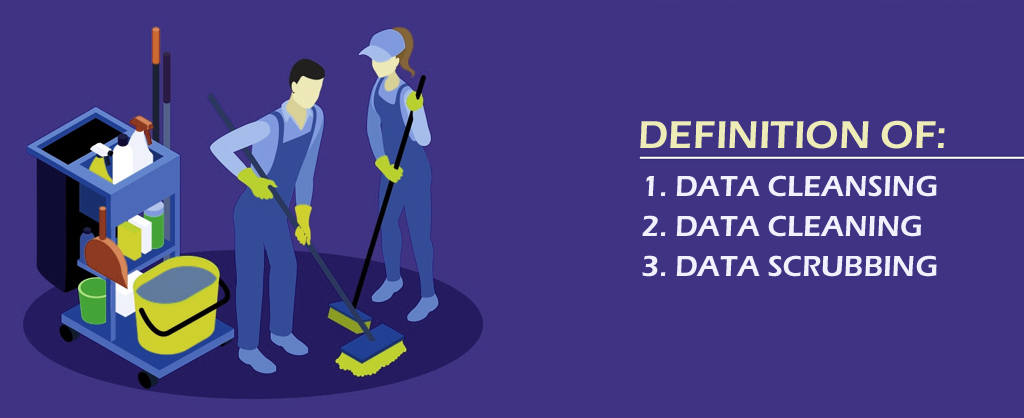Nothing is perfect in this world. And this applies to the data as well. The digital database is prone to inconsistencies, human error, spelling mistakes, incomplete details, and redundancies. As now the business world highly depends on databases, companies need to maintain the data and keep them updated. For this, data cleaning is an important task every business shouldn’t miss out on to make effective decisions.
Through this blog let us know what is the difference between data cleansing, data cleaning and data scrubbing.
What is Data Cleansing and Why is it important?
First, let’s discuss what is data cleaning. It is a process of editing incomplete, incorrect, duplicate, or any kind of erroneous data. This involves the identification of the errors and editing them by changing, removing, or updating the error with the right entry. With the help of data cleansing, businesses can improve the quality of the datasets and obtain consistent, reliable, and accurate data for effective decision-making.
“Thinking what is another term for data cleansing?” Data cleansing is also termed data scrubbing or data cleaning. It is an important section of the data management process and an essential component of the data preparation process. Through these processes, businesses can prepare databases used in data science applications and business intelligence. The process is carried out by data management experts or professionals like data quality analysts or engineers.
Data Cleansing, Data Cleaning, and Data Scrubbing – What’s the Difference?
Many times, all the three terms data cleansing, data scrubbing, and data cleaning are used interchangeably. They are generally considered to be similar. No doubt, data scrubbing is considered to be a section of data cleansing that particularly includes eliminating bad, old, duplicate, and unwanted data.
Apart from all these, another data scrubbing definition is well related to data storage. According to that, data scrubbing is an automatic function that controls the storage systems and disk drives to ensure that the data it contains can be identified and read easily to track any bad blocks or sectors.
Why is Clean Data Important to Us?
Businesses need to make important decisions regarding their operations regularly. And this is possible only through an accurate database. Hence, businesses look for data analytics to improve the performance of the business and gain a competitive advantage. Hence, it is important to clean the data for data science terms, BI, operational workers, sales representatives, marketing managers, and other business executives. This applies to every business category, type, and size.
If the data is dirty, the business data along with the customer details wouldn’t be accurate. As a result, the analytics application would be carried out with faulty information. This would result in faulty business decisions, missed opportunities, operational issues, misguided strategies, and much more. All these would indirectly reduce the profits and increase the cost.
What Types of Data Errors are Corrected in The Data Scrubbing Process?
Corrupt databases, incompatible data, invalid data, inaccurate data, etc. are the different issues in the datasets that are cleaned through the process of data cleansing. The reason behind such issues is human error while entering the data, or the use of diverse data formats, terminologies, and structures in different systems in the entire organization.
Some of the issues that are addressed through data cleansing projects are as follows:
Invalid or Typos and Missing Data
With the help of data cleansing, errors like wrong numerical entries, misspellings, missing values, syntax errors, typographical errors, etc. are corrected. These kinds of errors are termed structural errors.
Unreliable Data
Every system uses a proper format to enter the name, address, contact details, etc. which defers from one system to the other. Again data elements like identifiers and terms might also be different. A consistent database can be obtained for accurately analyzed data through data cleansing.
Duplicate Data
Data cleansing includes identifying duplicate entries or records in the database. Such entries are reconciled, that is either merged or eliminated with the help of deduplication measures for creating a single record.
Irrelevant Data
At times, the data becomes outdated. Hence, it might not be relevant for the company analytics and might affect the decisions inversely. Data cleansing eliminates such irrelevant data from the database. This reorganizes data preparation and eases the data amount required for processing resourcing and storing them as well.
Data Cleansing Process – Step-by-step Process
The possibility of a data cleansing task depends on the requirements of the analytics and the datasets. Here are certain essential steps for the data cleansing process.
1. Inspection and profiling
The first step towards the data cleansing process is inspecting the database and auditing it to know the data quality. In this step, the errors or issues are identified. Data profiling is carried out to learn about the relationship between the document and data elements to check the quality of the data for gathering the statistics on the data which helps to identify discrepancies, errors, and other issues.
2. Data Cleaning
This is the main step in the process of data cleansing. In this step, the errors in the database are corrected. Along with this, redundant, duplicate, and inconsistent data are addressed.
3. Data Verification
Once the database is cleaned, the experts who cleaned the database need to verify the database again. The verification process is carried out to verify whether the database is clean and follows the internal data quality standards and rules.
4. Data Recording
Finally, when the database is verified, the clean database should then be submitted to the business executives and IT experts for underlining data quality progress and trends. The report includes the total number of errors identified and reconciled. Again, the metrics of the database should also be updated.
Once the database is used for the data cleansing process, it then can be processed in the further data preparation process. In this step, processes like data transformation and data structuring are done to prepare the data for analytical uses.
What Are The Characteristics of a Clean Database?
For measuring the data cleanliness of the database, various attributes and characteristics are used along with the overall dataset quality including:
- completeness
- accuracy
- consistency
- timeliness
- integrity
- validity
- uniformity
The data management teams work on generating data quality metrics. This helps them track the characteristics and things like total errors and error rates in the database. Some experts also calculate the impact of the issues regarding the database on the business and the potential benefits of fixing such issues partly with the help of interviews and surveys.
What Are The Benefits of The Data Cleansing Process?
Once the data cleansing process is carried out effectively, here are some secret benefits it serves for business management.
- Enhanced decision-making
When the database is effectively cleaned, the analytics applications can help with more accurate results. Hence, businesses can make dependable decisions on business operations, strategies, government programs, and patient care.
- Improved sales and marketing
The data obtained from the customers is generally outdated, inconsistent, and wrong. Cleaning the database through sales systems and customer relationship management helps in improving the efforts taken for sales and marketing campaigns.
- Improved operational performance
Perfect and quality information assists associations with staying away from stock deficiencies, conveyance disasters, and other business issues that can bring about greater expenses, lower incomes, and harmed associations with clients.
- Improved use of database
Databases have turned into a critical corporate resource, yet they can’t produce business esteem if it isn’t utilized. By making information more reliable, information purging persuades business administrators and laborers to depend on it as a component of their positions.
- Reduction in data costs
Database purging prevents information blunders and issues from further proliferating in frameworks and examination applications. In the long haul, that sets aside time and cash, since IT and information supervisory groups don’t need to keep fixing similar blunders in informational collections.
Apart from all these, data cleansing and various other data quality processes are very crucial for data governance programs. The main aim of such programs is to make sure that the database is used fairly and is consistent as well. For a successful data governance ingenuity, a clean database is a must. And you can also boost your email marketing ROI through data cleansing.
What Challenges Needs to be Addressed During Data Cleansing
So, thinking what makes manually cleaning data challenging? Well, one of the issues with the data cleansing process is that it is time-consuming. This is because there are various issues to be cleared. Some of the challenges faced by experts include:
- learning how to deal with missing values in the database to avoid its negative impact on analytics application
- fixing conflicting information in frameworks constrained by various specialty units
- tidying up information quality issues in huge information frameworks that contain a blend of organized, semi-structured, and unstructured information
- having adequate assets and authoritative help
- managing data storage tower that obscures the data cleansing cycle
Wrapping Up
Several advanced techniques help in tackling issues regarding data cleansing. However, no matter how advanced the automated techniques might be, human intervention is still needed to maintain the quality of the data. When it comes to quality data, DataPlusValue is the top data scrubbing company that has helped administrators and analysts have complete trust in their database.
Our team helps you with the tools needed to transform, manage, and create quality data that helps to make effective and efficient business decisions. So, get in touch with the advanced data scrubbing services provider to improve the data culture in your business.













